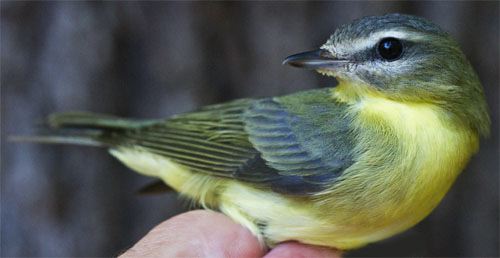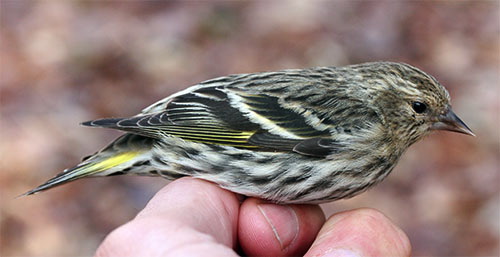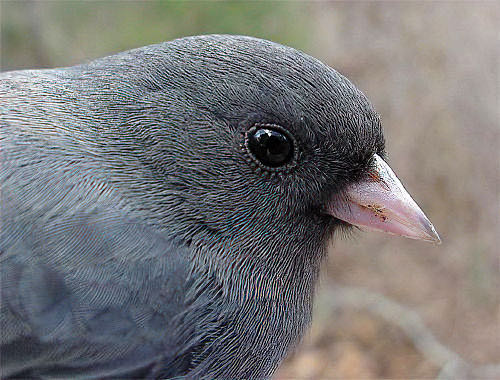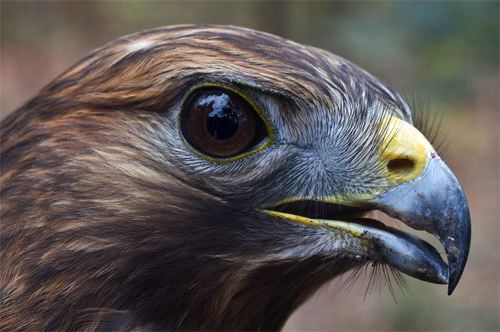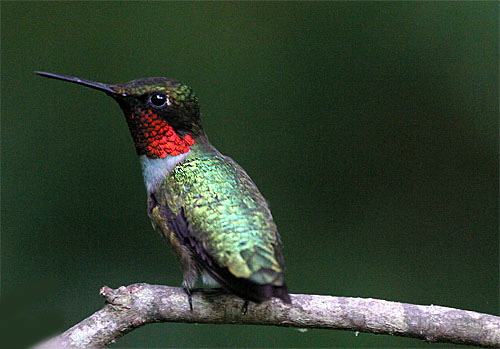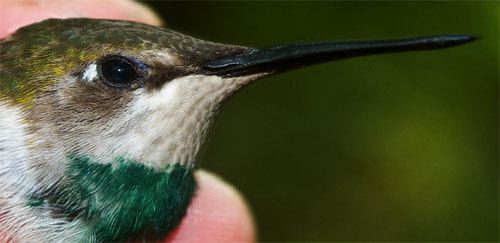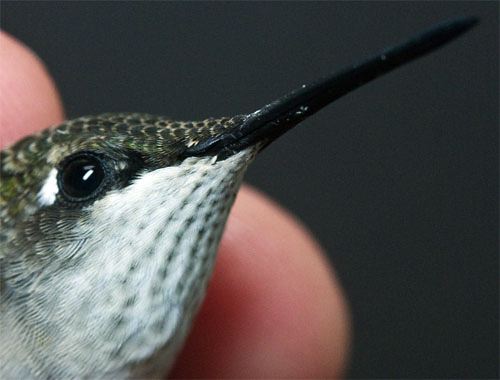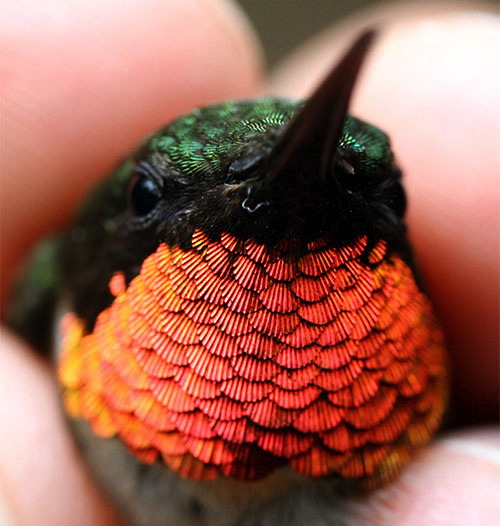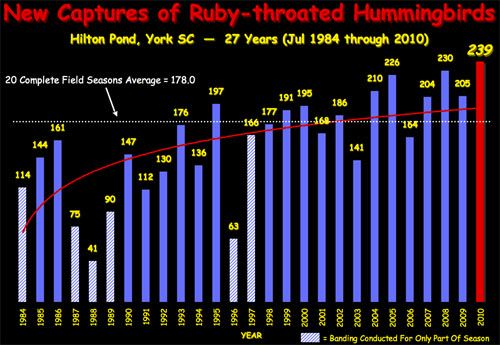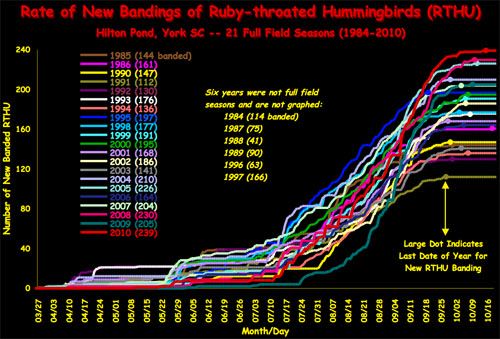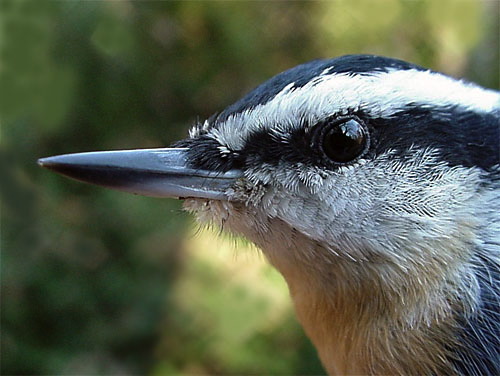|
|
|||
|
THIS WEEK at HILTON POND
29-31 December 2010 Installment #498---Visitor # (Back to Preceding Week; on to Next Week) |
|
SIGN UP FOR 2 OR MORE TRIPS; GET $100 OFF ON EACH Join fellow birders & educators as citizen scientists on 2011 Operation RubyThroat expeditions to observe, capture & band hummingbirds in Belize, Guatemala & Costa Rica. No experience necessary! |
|
2010 BIRD BANDING TOTALS: Research in ornithology and other disciplines began at Hilton Pond Center in the summer of 1982 when we returned from four years of graduate work in the hinterlands of Minnesota. Back home in the Carolinas we had hoped to continue research on behavioral ecology of Blue Jays but found too small a local population, so we shifted to a more general goal of learning as much as we could about all aspects of natural history in the Carolina Piedmont. Birds have always been a core topic of interest, of course, and in 29 years of general banding we've captured 54,877 individual birds of 124 species. In 1984 we began concentrating on migration, survival, and site fidelity in Ruby-throated Hummingbirds and in 27 field seasons have banded 4,288 ruby-throats.
All text, charts, tables & photos © Hilton Pond Center Many of those birds--including the Cedar Waxwing above--were measured, aged, sexed, banded, and safely released never to be seen again, while others became year-round residents or were encountered elsewhere. A substantial number have been recaptured locally at least once and some we can refer to as "trap junkies" that have been trapped or netted over . . . and over . . . and over again. Through capture, mark, and release, banding is a irreplaceable research tool that tells us things about birds we'd never know otherwise, and it's also a terrific teaching device that enthralls, entertains, and educates. Research and education together lead to better conservation of birds and their habitats--which is all the impetus we need to continue long-term banding studies at Hilton Pond Center. Unfortunately, our banding effort in 2010 was much less productive than we would have liked; several factors interfered so much with running mist nets and traps that we ended up with just 1,235 bandings--our second-lowest banding total for 22 "full years" of work at the Center, i.e., years in which we were in residence for all or most of the 12-month period. (Obligations elsewhere took us away from Hilton Pond during seven "partial" years.) As depicted on Chart 1 above, the only less productive year was 2003 when we banded 1,191 individuals; both 2003 and 2010 ended up far below our average yearly captures of 1,892. We also didn't do too well species-wise this year, capturing only 55--significantly below the long-term average of 68.4 and scarcely more than half the all-time high of 95 species banded in 1991.
So what WERE the factors that led to our low totals for 2010. For one, we can blame the weather. We've been at Hilton Pond for nearly three decades and don't really remember such temperature extremes as occurred in the past 12 months. For the Charlotte area--the closest major reporting station for which long-term records are easily accessible--2010 included the second warmest summer ever recorded with an average temperature of 81.1 degrees. Only 1993 was hotter--just barely--at 81.5 degrees. Such stifling heat is to be expected 'round these parts in August, but we expect June in the South to be a little more civil as we gradually get used to the dog days of summer. June 2010 didn't turn out to be the warmest on record for York and Hilton Pond Center--five others in more than a century of recorded weather history were hotter--but it WAS the first time June EVER had 18 consecutive days on which the thermometer went above 90 (see Chart 2 just above). Along the way June also tied two record highs on the 15th and 24th (orange numerals on the chart). Altogether, of the 92 days June through August, 67 of them reached highs of 90 degrees or more, with readings of 101 on 8 and 25 July. The bottom line is when it's above 90 degrees at the Center we generally refrain from running mist nets to avoid HYPERthermia among our captures, Besides, sweaty fingers on a bander's hands stick to feathers and don't make for easy net extractions. All text, charts, tables & photos © Hilton Pond Center CHART 3: Click on image above to open a larger chart in a new browser window And then came early winter 2010, which included the second coldest December on record for the greater Charlotte area, including York and Hilton Pond Center. Average temperature for the month was 34.8 degrees, with 33.4 degrees in 1917 the only colder December in a hundred-plus years. It wasn't just chilly--it was bitterly cold . . . frigid even! As noted on Chart 3 above, overnight lows for the month--with only three exceptions--were all below freezing, and some were 'way below. Objectively speaking, any month that includes FIVE all-time low temperatures--orange numerals on the chart above--instantly qualifies as a month too cold to run mist nets, if only to avoid HYPOthermia among captured birds. Besides, frosty fingers lose their flexibility and make net extractions both difficult and painful--especially when one of those nippy Northern Cardinals clamps down on a bander's half-frozen digit.
All text, charts, tables & photos © Hilton Pond Center We haven't quantified a third weather effect, and that's wind. It seemed in 2010 that even on days when temperatures were mild enough for mist netting the winds often picked up and gusted strongly enough to billow the nets or, in autumn, to fill them with leaves--in any case rendering them ineffective for capturing birds. And one more weather-related item that might have influenced banding success at the Center in 2010: This time last year the spillway of Hilton Pond was overflowing from heavy winter rains; by the end of this December water depth was about three feet below maximum--and has been since early summer. (At full pond the water level is only 18" below the predator guard on the Wood Duck box at right in the photo above.) Shallow water significantly lessens the impoundment's surface area from its normal 1.25 acres and has led to the demise of pond-rimming shrubs such as Hazel Alder, which once provided shelter and nesting sites for water-loving songbirds. There's no question uncooperative weather in 2010 reduced the number of days we deployed nets and led to diminished banding totals for Hilton Pond Center, but non-weather-related factors also had an effect. For one, our really high banding numbers during the early 1990s were directly related to how many nets we deployed and how often. Although we have three dozen designated net lanes on our 11-acre study site, most have gone unused during the past 15 years as we elected to run the ten nets in Quadrant #1 closest to the old farmhouse (see aerial photo above). That means we're sampling fewer habitats, including some alongside Hilton Pond itself.
All text, charts, tables & photos © Hilton Pond Center A second non-weather factor that reduces banding productivity is extended travel--including our now-annual mid-winter hummingbird expeditions to Central America. We catch lots of interesting and amazing birds in the Neotropics--join us in Costa Rica in January 2011 and you'll likely see a brightly colored Long-tailed Manakin (above)--but we DO miss prime months for trapping winter finches that once swelled our banding numbers at Hilton Pond.
All text, charts, tables & photos © Hilton Pond Center Although it's hard to document, a third non-weather influence on banding productivity at Hilton Pond Center has to do with habitat change. When we first occupied the site back in 1982 (photo above), there were only a few big trees around the old farmhouse; the rest was essentially open and at most a year or two into old-field succession after a century of grazing and row-crop farming--corn, cotton, and soybeans. We were determined not to cut 11 acres of grass, so we laid out and groomed our permanent trails and otherwise let nature take over.
All text, charts, tables & photos © Hilton Pond Center By the mid-1990s Broomsedge and asters had been replaced at the Center by Eastern Red Cedar, Sweetgum, and Winged Elm--a common threesome of early successional trees in the Carolina Piedmont. These are already giving way to oaks, hickories, Black Cherry, and other hardwoods, with a few Loblolly Pines scattered throughout. The good news is that we now host a nice mixed woodland; the bad news is that in 2010 (above) trees block our view of the sunset AND the young forest habitat no longer supports a variety of grassland and shrubland birds quite common locally until about ten years ago. Of the 124 bird species captured since 1982 at Hilton Pond Center, 23 have been banded at least 400 times (see Chart 4 above). Of those, the four "winter finches"--House Finch, Purple Finch, American Goldfinch, and Pine Siskin--continue to comprise nearly half of all bandings. Ruby-throated Hummingbirds are doing well (see below for details about our 2010 hummer bandings), but for many members of the "400 Club" annual numbers have declined significantly. Resident shrubland species such as Northern Cardinal, Eastern Towhee, Brown Thrasher, and Gray Catbird are banded at much lower rates, and even formerly common migrant shrub-loving species such as White-throated Sparrows and Dark-eyed Juncos are 'way down. Again, we are inclined to attribute these declines--at least in part--to local habitat change. Oddly, three members of the "Hilton Pond 400 Club" were not even represented in this year's banding tallies: Common Grackle (900 banded locally since 1982; high of 164 banded in 1983; 29-year average of 31 banded); Ruby-crowned Kinglet (570; 81 in 1991; 20 avg.); and American Robin (759 & 171 in 1991 & 26). Of these we doubt habitat change has made much difference, except perhaps for kinglets that always seemed to hang out in our once-dense growth of understory Eastern Red Cedars. With a low banding total for 2010 one should expect numbers of banded individuals by species would also be down, and that is indeed the case. Table 1 (below) lists all bird species banded since 1982, their banding tallies for 2010, and 29-year highs and averages for each.
All text, charts, tables & photos © Hilton Pond Center Of the 55 bird species banded at Hilton Pond Center in 2010, we had a record high for only one species--Ruby-throated Hummingbird--for which 239 new captures exceed the old record of 230 set two years ago. The number of hummers also was well above the 27-year average of 159. (RTHU banding did not begin until 1984, two years after we moved to the Center.) Two other rarely banded species--Philadelphia Vireo (one banded this year) and Black-throated Green Warbler (two banded)--tied annual banding highs for their species. For another 15 species--those in GREEN on the table above--we managed to band average or above-average numbers. Except for Mourning Doves (34 banded, well above the average of 16) and Chipping Sparrows (99 banded, avg. 59), the differences were not all that significant. The remaining 37 species in BLACK type all were banded at below-average levels in 2010. A variety of factors probably affected our banding results for 2010: Poor weather (hot AND cold), out-of-country hummingbird expeditions, numbers of nets and traps deployed, work-related travel, habitat changes, even bander illness. And, as much as we don't like to think about unpleasant scenarios, it may be there are just fewer birds in the world than when we began banding at Hilton Pond Center nearly three decades ago. We hope efforts to conserve habitat here in the U.S. AND on Neotropical migrants' wintering grounds in Central and South America will counteract any such bird losses, but we'll just have to wait and see. In any case, the just-finished 2010 banding year wasn't our slowest ever at Hilton Pond, but it was close. 2010 BANDING NOTES OF INTEREST, Twelve months is a long time in the life of a bird bander, so we have plenty of banding highlights to report for 2010 from Hilton Pond Center. Several are listed below, along with a few notes about returns and recaptures.
All text, charts, tables & photos © Hilton Pond Center It was probably only happenstance that a Chipping Sparrow (above) was our first bird banded at Hilton Pond Center on 6 January 2010 and that another was the final capture of the year late on the afternoon of 31 December.
All text, charts, tables & photos © Hilton Pond Center The Eastern Towhee male (above) recaptured the week of 22-31 March 2010 was banded at the Center as a local fledgling in 2003. At the age of eight years he continues to thrive despite a mild case of scaly leg mites.
All text, charts, tables & photos © Hilton Pond Center Purple Finches (unknown sex above) were still present at the Center as of 31 March 2010, as was a single White-throated Sparrow--one of a very few we observed all winter. The last week of the month saw its usual influx of Chipping Sparrows, including quite a few returning individuals banded as far back as 2007. A somewhat late white-throat--only the second banded this year--was trapped on 13 April. With just five WTSP banded last fall, that made only seven new ones handled during the winter of 2009-2010--our lowest ever for a species that has averaged 69 per year since 1982. Another WTSP captured on 17 Apr was here rather late for this northern-breeding species.
All text, charts, tables & photos © Hilton Pond Center A female Carolina Chickadee (above) with a brood patch captured on 13 May 2010 made her species the 23rd member of the elite "400 Club" of birds banded at the Center since 1982 (see Chart 4 above). Next in line: Song Sparrows with 320. Another breeding female chickadee caught on 14 May had been banded locally in 2005, making her a rather old 6th-year bird. (Known longevity record for the species is a West Virginia individual aged 10 years 8 months.) An after-seventh-year male Northern Cardinal banded in 2003 and recaptured 16 May was even older. We recaptured two adult male piciforms at Hilton Pond Center the week of 1-10 May 2010--
All text, charts, tables & photos © Hilton Pond Center The immature Nashville Warbler netted on 10 September 2010 was in the running for our "Banded Bird of the Year" in that it became only the 8th of its species caught locally since 1982. Alas, it slipped to second place on 6 October with the capture of our second-ever Philadelphia Vireo (above).
All text, charts, tables & photos © Hilton Pond Center Winter (almost) officially arrived six weeks ahead of schedule on 4 November 2010 when Pine Siskins (above) appeared at the Center--our first since the spring of 2008; by that afternoon we had banded 15 of them. (Interestingly, a couple of old banded American Goldfinches arrived with the siskins; perhaps they showed them the way.) And then . . .
All text, charts, tables & photos © Hilton Pond Center . . . the following day (5 November) the first Purple Finches of the season showed up around Hilton Pond, followed that afternoon by the final member of the winter triumvirate--Dark-eyed Junco (above). It's probably no coincidence a rainy cold front moved through on 4-5 November, or that overnight temperatures were in the 30s.
On 22 November 2010 while deploying a bal-chatri trap to capture Belted Kingfishers, we caught instead an apparent third-year Red-shouldered Hawk (above)--our ninth in 29 years at Hilton Pond Center. RUBY-THROATED HUMMINGBIRDS
All text, charts, maps, tables & photos © Hilton Pond Center Anyone who follows our work at Hilton Pond Center knows we have a special affinity for Ruby-throated Hummingbirds. Normally at season's end we summarize the year's hummer work in a full installment of "This Week at Hilton Pond," but for 2010 we're simply folding it into our end-of-year banding report. Here are some hummingbird notes of interest:
All text, charts, maps, tables & photos © Hilton Pond Center
All text, charts, maps, tables & photos © Hilton Pond Center
All text, charts, tables & photos © Hilton Pond Center
All text, charts, tables & photos © Hilton Pond Center CHART 5: Click on image above to open a larger chart in a new browser window
All text, charts, tables & photos © Hilton Pond Center CHART 6: Click on image above to open a larger chart in a new browser window
All text, charts, maps, tables & photos © Hilton Pond Center IT'S NOT ONLY ABOUT BANDING: HILTON POND YARD LIST 2010 Although we always tally birds we band annually at Hilton Pond Center, until recently we never really kept track of the number of species seen or heard during the calendar year; i.e., we didn't keep a "Yard Year List." We decided to start in 2007 when we ended up encountering 90 of the 168 species on the Center's master list--more than half (53.57%) the birds then known to occur on the property. In 2008 we did a bit better, first by adding two NEW species to the yard list: Fish Crow (species #169) and Solitary Sandpiper (#170); our annual total in 2008 was 96 species observed from a "possible" list of 170, or 56.47%. In 2009 we backslid, mostly because we were away from the Center for more time than usual. Nonetheless, we still saw 88 of 170 species (51.76%) on our "yard list" but added no new species.
All text, charts, maps, tables & photos © Hilton Pond Center Alas, 2010 was even slower than last year with only 75 species seen (44.12%)--no new ones--in part because the summer was too hot and the winter too cold. (We also spent a lot of time in the Neotropics January through March.) If we had to choose a "Best Bird Sighting of the Year," it would probably be the Red-breasted Nuthatch (above) that first appeared on 19 October (and was netted the same day), although we also were pleased by almost-daily appearances around Hilton Pond of a Belted Kingfisher pair living up to their name through much of the fall. All text, charts, tables & photos © Hilton Pond Center If you have a Twitter account and liked this page, you can recommend "This Week at Hilton Pond" to your followers by clicking on the Tweet button: Tweet Follow us on Twitter: @hiltonpond
|


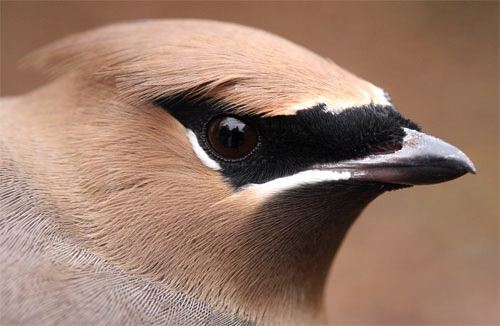
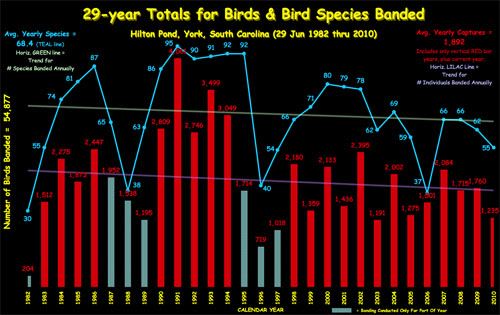

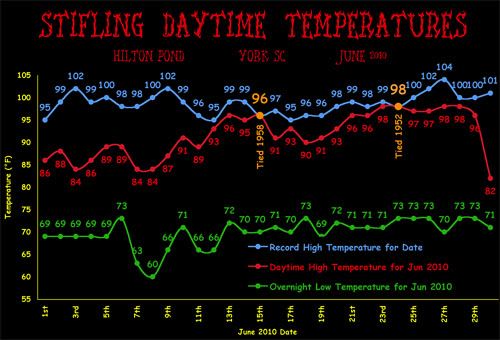
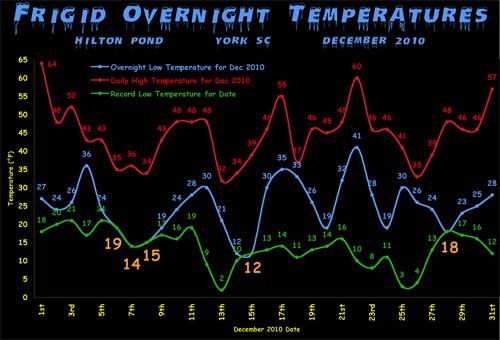
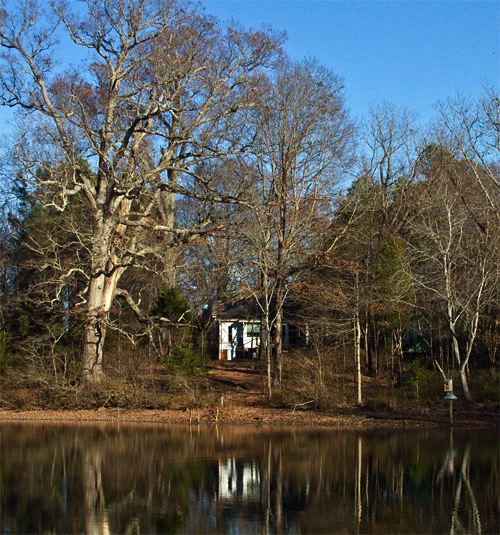
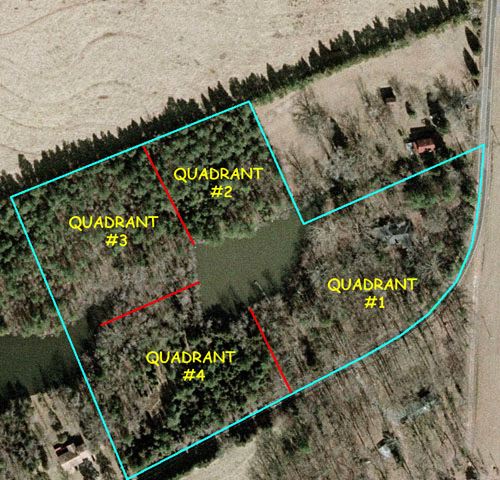
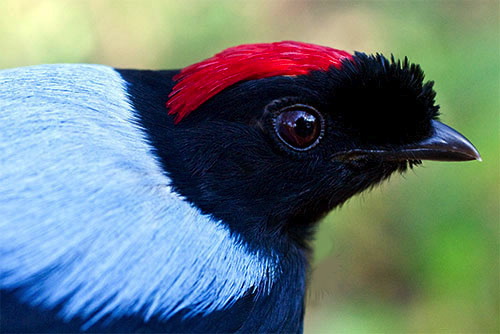
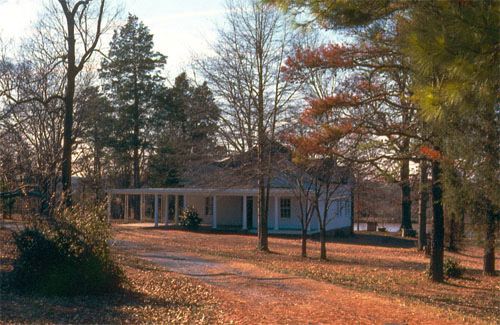
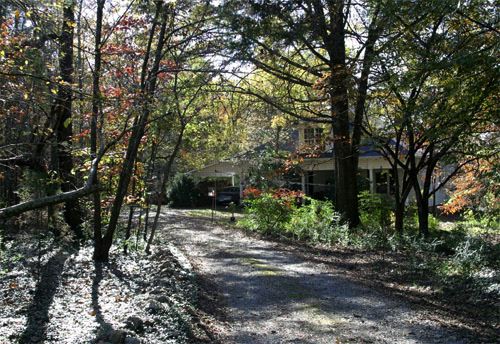
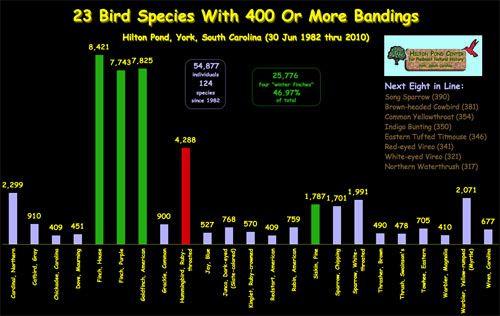
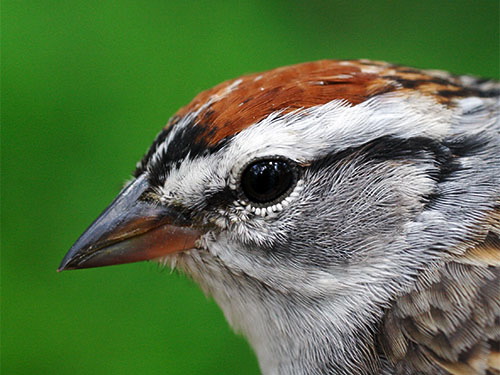
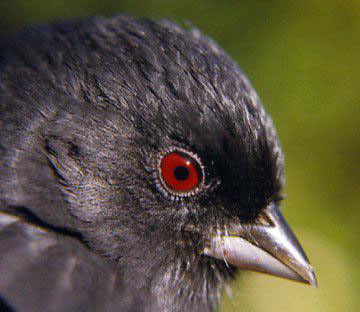
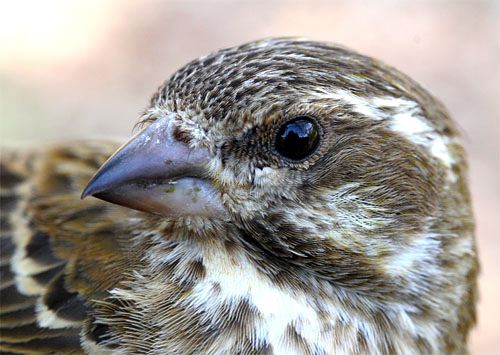
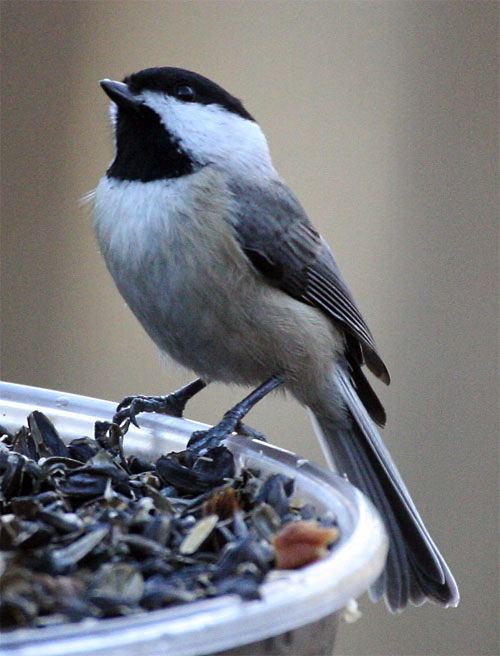
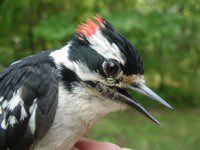 Downy Woodpecker (right) and Red-bellied Woodpecker. Each had a well-developed brood patch, a sure indication these birds were helping their mates with incubation duties. This is a common occurrence for woodpeckers. However, among songbirds (Passeriformes), brood patches are rare for males; exceptions include the Great Crested Flycatcher. (NOTE: In some songbirds, males sit on--or over--the eggs but do not develop brood patches.)
Downy Woodpecker (right) and Red-bellied Woodpecker. Each had a well-developed brood patch, a sure indication these birds were helping their mates with incubation duties. This is a common occurrence for woodpeckers. However, among songbirds (Passeriformes), brood patches are rare for males; exceptions include the Great Crested Flycatcher. (NOTE: In some songbirds, males sit on--or over--the eggs but do not develop brood patches.)